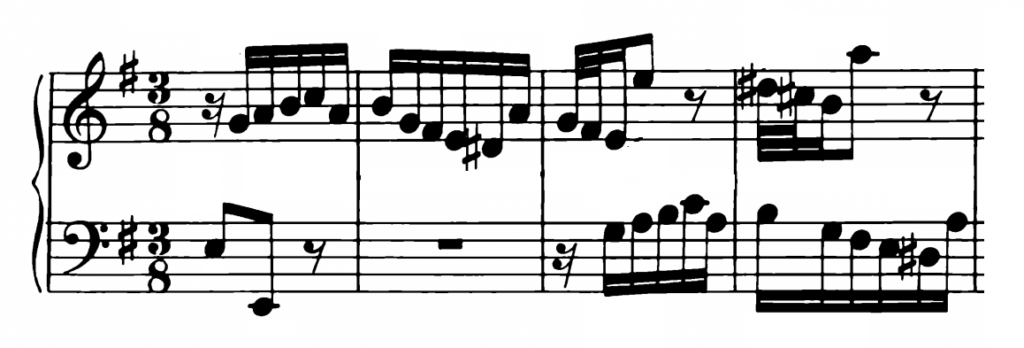Analysis
Contents
Prelude
SUMMARY:
Bars 1-48: Period I. Supertonic Pedal – i.e., Dominant of the Dominant of the original key (Bars 29-33), followed by a Dominant Pedal (Bars 33-37). Ending with a Perfect Cadence in the key of the Dominant Minor, B.
Bars 49-108: Period II. Dominant Pedal (Bars 86-89), followed by a Tonic Pedal, firmly establishing the key (Bars 89-92). Ending with a Perfect Cadence in the key of the Tonic, E.
REMARKS:
This Prelude is divided into tow parts by the double bar.
The great centres of gravity in each part (emphasized by the employment of the Pedals) are very notable.
Bar 37 and the nine following bars contain in the upper part, a figure, the early part of which is formed from the first bar of Theme I taken by Inversion. This figure is imitated freely by the under part at one bar’s distance.
At the beginning of the second half of the movement (Bar 49) a new Theme (Theme II) is proposed by the upper part, the lower part at the same time proposing Theme I by Inversion.
Period I divides momentarily at Bar 17(.5), where there is a Perfect Cadence in the key of the Relative Major (G).
Period II has a marked division at Bar 72, where there is a Perfect Cadence in the key of the Subdominant Minor (A).
There are two Pedals in each part of the movement.
- In the first part (1) at Bars 29-33 on the Supertonic to prepare the mind for the conclusion of this first half in the key of the Dominant Minor (B); (2) at Bars 33-37 the Dominant Pedal itself is but down the moment the first Pedal has done its work, firmly clenching its key and ending in it at the double bar.
- In the second part: (1) at the Bars 86-89 the Dominant Pedal, and (2) at Bars 89-92 the Tonic Pedal, which firmly settle the Tonic key.
Bars 85-92 are a transition into the Tonic key of material employed in the key of the Dominant in the first part of the movement (Bars 29-37).
The remarkably fine Deceptive Cadence at Bar 103 is very notable, and is caused by the Dominant dropping heavily to the Major 7th below, instead of merely taking the conventional upward step of a second (Bars 102, 103, Bass part).
Fugue
SUMMARY:
ENUNCIATION SECTION:
Bars 1-6: Subject in Treble [E minor].
Bar 6: Codetta (of six quavers/eighth notes), leading from E minor to B minor.
Bars 6-12: Real Answer in Alto, with Counter-subject in Treble [B minor].
Bars 12-18: Subject in Bass, with Counter-subject in Alto [E minor].
MODULATORY SECTION:
Bars 18-23: Episode I, modulating from E minor to G major.
Bars 23-29: Subject in Treble, with Counter-subject in Alto (slightly altered, Bar 27) [G major].
Bars 29-35: Answer in Alto, with Counter-subject in Treble [D major].
Bars 35-41: Episode II, modulating from D major to B minor.
Bars 41-47: Subject in Bass, with Counter-subject in Alto [B minor].
Bars 47-50: Episode III, modulating from B minor to E minor.
Bars 49-55: Subject in Alto, with Counter-subject in Bass [E minor].
Bars 55-59: Episode IV, modulating through A minor, D minor, G and C in Sequence.
Bars 59-65: Subject in Treble, with Counter-subject in Alto (slightly altered, Bar 64) [A minor].
Bars 65-70: Episode V, modulating back to E minor, half-close and pause.
RECAPITULATORY SECTION:
Bars 70-71: Subject (last fragment) in Bass [E minor].
Bars 71-72: Subject (last fragment), in Treble, by Inversion.
Bars 71-77: Subject (in full) in Bass, with Counter-subject in Alto [E minor].
Bars 77-86: Coda [E minor].
SUMMARY:
Exposition: Bars 1-18.
Counter-exposition: None.
Stretti: None.
Episodes: Five.
(1) Dominant Pedal: Bars 78-81.
(2) Dominant Pedal: Bars 84-85.
REMARKS:
- This Fugue has a “real” Answer, and would be styled as a “real” Fugue.
- The Subject is remarkable for its elaborate character and in length it exceeds any of the other Fugues in this series. It may be divided into four short sections, (1) at Bar 2, (2) at Bar 3, (3) at Bar 4, and (4) at Bar 6. This latter section is frequently made use of by similar and contrary motion throughout the Fugue. It also forms a large portion of the material of the complementary part – i.e., that which accompanies the Subject and Counter-subject.
- The Counter-subject does not accompany the Answer at once, not being brought in until its third bar. It commences with long notes (minims/half notes) and is in the sharpest contrast to the Subject itself. It is of rather free construction, intervals of the fourth and seventh being used by a skip.
- In Bar 27 it is slightly altered in order to keep up the interest and to keep up the motion in the various parts. An alteration also for the same reason in Bar 64.
- Five Episodes:
- Episode I (Bar 18). An entirely new figure appears first in Alto, freely imitated by the Treble, accompanied by a running Bass formed from the last part of the Subject. In Bar 21 and onwards all three parts are formed from this part of the subject.
- Episode II (Bar 35) is mainly formed from the second half of Bar 5, free imitation being employed in all the parts.
- Episode III (Bar 47) is much the same as Episode I in construction.
- Episode IV (Bar 55) consists of another new figure in the Alto, a Treble formed from Bars 5 and 6 of the Subject and a Bass proceeding steadily in crotchets (quarter note).
- Episode V (Bar 65) is made up from Bars 5 and 6 of the Subject treated in similar and contrary motion.








